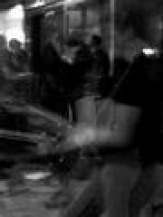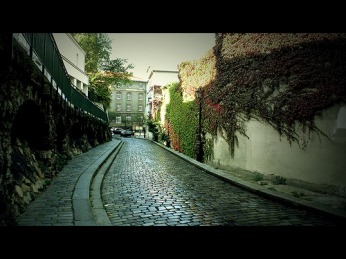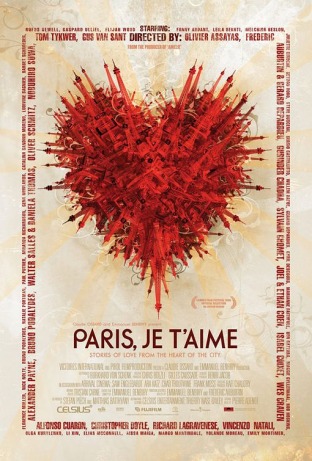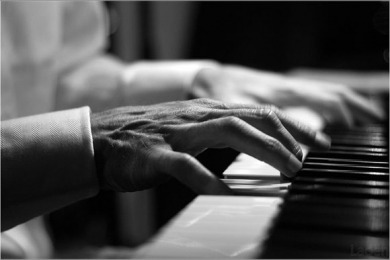Non Je Ne Regrette Rien
Non, Rien De Rien,
Non, Je Ne Regrette Rien
Ni Le Bien Qu`on M`a Fait, Ni Le Mal
Tout Ca M`est Bien Egal
Non, Rien De Rien,
Non, Je Ne Regrette Rien
C`est Paye, Balaye, Oublie, Je Me Fous Du Passe
Avec Mes Souvenirs J`ai Allume Le Feu
Mes Shagrins, Mes Plaisirs,
Je N`ai Plus Besoin D`eux Balaye
Les Amours Avec Leurs Tremolos Balaye Pour Toujours
Je Reparas A Zero
Non, Rien De Rien,
Non, Je Ne Regrette Rien
Ni Le Bien Qu`on M`a Fait, Ni Le Mal
Tout Ca M`est Bien Egal Non,
Rien De Rien, Non, Je Ne Regrette Rien
Car Ma Vie, Car Me Joies
Aujourd`hui Ca Commence Avec Toi
Non, Rien De Rien,
Non, Je Ne Regrette Rien
Ni Le Bien Qu`on M`a Fait, Ni Le Mal
Tout Ca M`est Bien Egal
Non, Rien De Rien,
Non, Je Ne Regrette Rien
C`est Paye, Balaye, Oublie, Je Me Fous Du Passe
Avec Mes Souvenirs J`ai Allume Le Feu
Mes Shagrins, Mes Plaisirs,
Je N`ai Plus Besoin D`eux Balaye
Les Amours Avec Leurs Tremolos Balaye Pour Toujours
Je Reparas A Zero
Non, Rien De Rien,
Non, Je Ne Regrette Rien
Ni Le Bien Qu`on M`a Fait, Ni Le Mal
Tout Ca M`est Bien Egal Non,
Rien De Rien, Non, Je Ne Regrette Rien
Car Ma Vie, Car Me Joies
Aujourd`hui Ca Commence Avec Toi
The Immigrant’s Crisis in Three Films: La Haine - Salut Cousin! - L'esquive
Since the independence movement of North Africa in the 1960’s, an increasing immigrant population has come to France in search of asylum and a chance to live life like the French. Harsh questions of identity, proper assimilation, and social and political rights, however, have laid the groundwork for a cultural clash. Three directors, Mathieu Kassovitz, Merzak Allouache, and Abdel Kechiche address this conflict between French native and immigrants in three distinct styles. I am going to explore how effective each film stlye, objective, and resolution is in connecting the viewer with the increasingly critical situation in France.
Director Mathieu Kassovitz’s vision for La Haine (1995) is a black and white documentary-like film portraying 24 hours in the life of three youth living in les banlieues of Paris. Kassovitz begins the film with live documentation from riots that took place in the 1990’s. This camera style is maintained throughout the course of the film, creating a natural and realistic feel to the movie. Johann Sadock from Contemporary French and Francophone studies believes the film « montre quand meme bien une certain réalité des banlieues » (Sadock 63). The entire film is centered around the violence and disconnect between second generation immigrant youths and the French police. The characters use harsh language, often speak Verlan (a popularized slang among Maghrebi), and are called gangsters. Phil Powrie emphasizes in The Cinéma of France that « the rascism, urban violence, riots and clashes between youth and police depicted in La Haine all reflect that period’s preoccupation with what has been termed la fracture sociale, or social breakdown » (Powrie 238). Kassovitz comments on this issue in the most direct and raw manner of all three directors. He does not leave any room to question the existence of a desperate and destructive environment on the fringe of Paris. Kassovitz does not instill any semblance of hope, however, for these youth to one day part from les banlieues and fluidly assimilate to French society. At least, not without parting with their immigrant-jewish, beur, black-identity.
Director Merzak Allouache’s Salut Cousin (1996) takes a lighter, more nostalgic approach to addressing the ‘unexpected’ difficulties immigrants encounter in France. He blends humor and ironic misunderstandings into the story of cousins Mok and Alilo. While Mok attempts to easy into French society or ‘blend’ to the point of passing as French, Alilo enjoys being Algerian in France. Allouache presents the conflict through Mok’s underlying denial of his true Algerian identity and Alilo’s romanticized view of France and inability to understand the heavy reality of immigrant life. In Studies in European Cineman, Darren Waldron stresses that « unexpected events punctuate the diegetic flow and provide the springboard not only for high farce, but also for tragedy » (Waldron 36). Allouache focuses on the nostalgia for loss of immigrant identity in a new homeland. While he does set the film in les banlieues of Paris, these neighborhoods come to represent a community supporting a mélange of identities. Violence is a subtle, if not voiceless theme in Salut Cousin ! Allouache succeeds in replicating the difficulties these populations face. However, his off beat, comical scope of a crucial issue and nonsensical characters make it a challenge for the viewer to take this film seriously enough to understand the true French/Immigrant divide.
Directed by Abdel Kechiche, L’esquive (2004) provides a more recent and balanced look into relations between French and immigrant youth. Richard Porton from Cineaste Journal illustrates the film as an “ideosyncratic blend of social commentary and romantic comedy” with what viewers perceive as “glimmers of hope” (Porton 46-47). Kechiche follows a group of middle school kids from les banlieues as they work on producing an 18th century French play in the context of their unforgiving daily lives. The play mirrors the division of French and immigrants as it deals with the division of class and power. It also addresses the question of changing identity as the servants disguise themselves as masters and vice versa. One character Krimo maintains a hard exterior around his male friends, father in prison, and police. Conversely, Kechiche shows Krimo’s vulnerability to young love through the boy’s captivation with Lydia and willingness to act in the play. Throughout the film, Kechiche maintains a connection between themes of violence and love and young innocence. This film is powerful in it's message until the final scene where Kechiche decides not to act in the play and watches apathetically from outside. All the other characters appear content and excited to be together, taking pictures and receiving flowers from their parents. Kechiche does not end on a definitive note, so the viewer leaves more concerned about the degradation of Krimo and Lydia's young love instead of the hard hitting question of identity and conflict.
Director Mathieu Kassovitz’s vision for La Haine (1995) is a black and white documentary-like film portraying 24 hours in the life of three youth living in les banlieues of Paris. Kassovitz begins the film with live documentation from riots that took place in the 1990’s. This camera style is maintained throughout the course of the film, creating a natural and realistic feel to the movie. Johann Sadock from Contemporary French and Francophone studies believes the film « montre quand meme bien une certain réalité des banlieues » (Sadock 63). The entire film is centered around the violence and disconnect between second generation immigrant youths and the French police. The characters use harsh language, often speak Verlan (a popularized slang among Maghrebi), and are called gangsters. Phil Powrie emphasizes in The Cinéma of France that « the rascism, urban violence, riots and clashes between youth and police depicted in La Haine all reflect that period’s preoccupation with what has been termed la fracture sociale, or social breakdown » (Powrie 238). Kassovitz comments on this issue in the most direct and raw manner of all three directors. He does not leave any room to question the existence of a desperate and destructive environment on the fringe of Paris. Kassovitz does not instill any semblance of hope, however, for these youth to one day part from les banlieues and fluidly assimilate to French society. At least, not without parting with their immigrant-jewish, beur, black-identity.
Director Merzak Allouache’s Salut Cousin (1996) takes a lighter, more nostalgic approach to addressing the ‘unexpected’ difficulties immigrants encounter in France. He blends humor and ironic misunderstandings into the story of cousins Mok and Alilo. While Mok attempts to easy into French society or ‘blend’ to the point of passing as French, Alilo enjoys being Algerian in France. Allouache presents the conflict through Mok’s underlying denial of his true Algerian identity and Alilo’s romanticized view of France and inability to understand the heavy reality of immigrant life. In Studies in European Cineman, Darren Waldron stresses that « unexpected events punctuate the diegetic flow and provide the springboard not only for high farce, but also for tragedy » (Waldron 36). Allouache focuses on the nostalgia for loss of immigrant identity in a new homeland. While he does set the film in les banlieues of Paris, these neighborhoods come to represent a community supporting a mélange of identities. Violence is a subtle, if not voiceless theme in Salut Cousin ! Allouache succeeds in replicating the difficulties these populations face. However, his off beat, comical scope of a crucial issue and nonsensical characters make it a challenge for the viewer to take this film seriously enough to understand the true French/Immigrant divide.
Directed by Abdel Kechiche, L’esquive (2004) provides a more recent and balanced look into relations between French and immigrant youth. Richard Porton from Cineaste Journal illustrates the film as an “ideosyncratic blend of social commentary and romantic comedy” with what viewers perceive as “glimmers of hope” (Porton 46-47). Kechiche follows a group of middle school kids from les banlieues as they work on producing an 18th century French play in the context of their unforgiving daily lives. The play mirrors the division of French and immigrants as it deals with the division of class and power. It also addresses the question of changing identity as the servants disguise themselves as masters and vice versa. One character Krimo maintains a hard exterior around his male friends, father in prison, and police. Conversely, Kechiche shows Krimo’s vulnerability to young love through the boy’s captivation with Lydia and willingness to act in the play. Throughout the film, Kechiche maintains a connection between themes of violence and love and young innocence. This film is powerful in it's message until the final scene where Kechiche decides not to act in the play and watches apathetically from outside. All the other characters appear content and excited to be together, taking pictures and receiving flowers from their parents. Kechiche does not end on a definitive note, so the viewer leaves more concerned about the degradation of Krimo and Lydia's young love instead of the hard hitting question of identity and conflict.
Begins with medium shot to close up shot of just hands and disks. This movement contextualizes the sound for the viewer and creates a strong fidelity between his actions and the sound. This is different than if we see a d.j. from across the room and their are people dancing where the viewer could assume that the d.j. is playing. Here the viewer instantly connects with the d.j. in his small room. His hands are the only movement in the shot which is objectively black and white. This clips is shot through a subjective lens. This is his element and it is easy to appreciate him when he is acting so comfortably.
Next, the camera moves to a back shot, where the d.j. is in focus but the outside courtyard is blurred moves to a zooming out shot leaving his window. You can hear people laughing and talking in the distance but this panning shot of the window places the d.j. in les banlieues.
Music remains diegetic as the sound switches from inside a room to a louder, more echoed quality that would play in a large space (This effect pulls the viewer inside the scene). Then an aerial shot (sky-down) creates a naturalistic feel. This one scene in the movie is so realistic, could have come from a documentary. The above shot is objective, but the music is explicitly conveying a message. There is even one moment when the light catches the camera. This is an effect that may be edited out of a hollywood film, but they leave it.
The song is strong and harsh and the d.j. can manipulate the words to rewind, fast forward, scratch out, or add more words. There is an Edith Piaf song which comes in under the rap music. The song is « Non, je ne regrette rien » which was dedicated to the foreign french army fighting in Algeria during the Algerian war for independence.
Next, the camera moves to a back shot, where the d.j. is in focus but the outside courtyard is blurred moves to a zooming out shot leaving his window. You can hear people laughing and talking in the distance but this panning shot of the window places the d.j. in les banlieues.
Music remains diegetic as the sound switches from inside a room to a louder, more echoed quality that would play in a large space (This effect pulls the viewer inside the scene). Then an aerial shot (sky-down) creates a naturalistic feel. This one scene in the movie is so realistic, could have come from a documentary. The above shot is objective, but the music is explicitly conveying a message. There is even one moment when the light catches the camera. This is an effect that may be edited out of a hollywood film, but they leave it.
The song is strong and harsh and the d.j. can manipulate the words to rewind, fast forward, scratch out, or add more words. There is an Edith Piaf song which comes in under the rap music. The song is « Non, je ne regrette rien » which was dedicated to the foreign french army fighting in Algeria during the Algerian war for independence.
The Girl in the Café
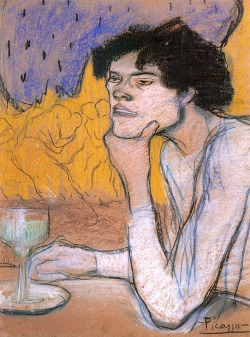
The Girl in the Café is a warm and inspiring story of a man and a woman who unexpectedly make an impact on each others lives. Director David Yates creates an almost love story, which truly seeks to understand how a little love can change one persons thoughts and actions. Yates immediately grabs the viewers attention with Bill Knightly's awkward disposition. Specifically, when he is forced to share a seat with a woman, Gina in a full café.
At First, the camera shot is at medium distance and with an objective lens. The viewer is restricted to what both Gina and Knightly's character, Lawrence observe. As the characters fall into a more involved conversation, however, the camera pans subjectively from a close up of Gina to a close up of Lawrence. This instills a sense of proximity and understanding in the audience. Yates brings the viewer inside Gina and Lawrence's conversation where the viewer feels the tension and discomfort of the encounter.
Music provides a facet for emotional connection in this film. It augments the mood of strange fondness and deepens the mood of sadness and loss of human life. Even though the viewer may not understand the attraction Gina has to Lawrence, they can understand a human's most inherent need to be loved. The care and tenderness Gina and Lawrence give one another makes their perspective lives worthwhile. Ultimately, Yates brings to screen the human potential to love and how that single action can and does impact others.
At First, the camera shot is at medium distance and with an objective lens. The viewer is restricted to what both Gina and Knightly's character, Lawrence observe. As the characters fall into a more involved conversation, however, the camera pans subjectively from a close up of Gina to a close up of Lawrence. This instills a sense of proximity and understanding in the audience. Yates brings the viewer inside Gina and Lawrence's conversation where the viewer feels the tension and discomfort of the encounter.
Music provides a facet for emotional connection in this film. It augments the mood of strange fondness and deepens the mood of sadness and loss of human life. Even though the viewer may not understand the attraction Gina has to Lawrence, they can understand a human's most inherent need to be loved. The care and tenderness Gina and Lawrence give one another makes their perspective lives worthwhile. Ultimately, Yates brings to screen the human potential to love and how that single action can and does impact others.
Salut Cousin!
Merzak Allouache presents Salut Cousin! as a lighthearted commentary on a heavy topic of immigration and cultural clashes in France. Allouache shows the changes foreigners must endure through "Mokrane," who prefers "Mok" because of its less identifiable origins. Mok's differences become more vivid as his cousin, Alilo, visits from Algeria. Alilo has difficulty understanding Mok's new life in "les banlieues" of Paris but prefers many freedoms to Algeria. North African rap music is a non-diegetic constant throughout the scenes in "les banlieues." Allouache highlights the ironic living situation of starkly different cultures now working grouped together against French society.
The viewer can see the disdain French people have for an unknown immigrant culture as Allouache observes the older, white generation's daily reactions to Mok and Alilo through a subjective lens (i.e. the bus scenes). Mok tries again and again to "pass" as French so he can escape the discrimination he would face for being Arabic.
Music is a representation of a culture shift in this film. Traditional Arabic music provides the score for this film instilling a sense of nostalgia Mok perhaps feels for Algeria. However, this is refuted when Mok tries to rap exclusively in Arabic, not in an arab-franco medium, and is pulled off stage by his fellow youth. Music is the only genre that accepts the mixing of French and Arabic as legitimate.
Allouache seeks to find a place for Algerian identity, or African identity in France in "Salut Cousin!" While he succeeds in replicating the difficulties these populations face, his off beat, comical scope of a crucial issue and nonsensical characters make it a challenge for the viewer to take this film seriously.
The viewer can see the disdain French people have for an unknown immigrant culture as Allouache observes the older, white generation's daily reactions to Mok and Alilo through a subjective lens (i.e. the bus scenes). Mok tries again and again to "pass" as French so he can escape the discrimination he would face for being Arabic.
Music is a representation of a culture shift in this film. Traditional Arabic music provides the score for this film instilling a sense of nostalgia Mok perhaps feels for Algeria. However, this is refuted when Mok tries to rap exclusively in Arabic, not in an arab-franco medium, and is pulled off stage by his fellow youth. Music is the only genre that accepts the mixing of French and Arabic as legitimate.
Allouache seeks to find a place for Algerian identity, or African identity in France in "Salut Cousin!" While he succeeds in replicating the difficulties these populations face, his off beat, comical scope of a crucial issue and nonsensical characters make it a challenge for the viewer to take this film seriously.
La Haine
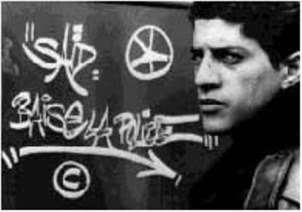
Réalisé par Mathieu Kassovitz, "La Haine" est un film qui traite sur le sujet de la violence et des relations entres les policiers et les gens qui habitent aux banlieues chez Paris. Kassovitz suit trois jeunes hommes en particulier, un qui vient d'Afrique, un qui est juif, et un qui est beur (arab et de Nord d'Afrique). Comme spectateur, on s'attend aux dificultés entre ces trois amies qui ne connaissent pas la meme culture. Pourtant, c'est les banlieues et leurs vies tristes et difficiles qui rende les hommes plus proches. Kassovitz emploie des coups subjectifs souvent pour montrer les vrais sentiments de chaque homme. Pour Vinz c'est son pétard (revolver) et les coups avec la miroir ou la spectateur voit son determination. Pour Hubert c'est sa connaissance de la rue et aussi ses poings ou on voit son aversion a la violence. Pour Said, c'est d'etre le concliateur entre ses deux amies et son capacité de s'entendre bien avec tout le monde (par exemple, les policiers, Hubert, Vinz, et des gangsters) Enfin c'est le pétard comme symbole qui souligne le theme la plus forte dans ce film, la violence. Kassovitz montre le bruit de tirer un pétard fréquenement pendant l'histoire. Neanmoins, c'est jamais le pétard de Vinz qui tue jusqu'au fin du film. Vinz fait une geste avec ses propres doights pour "tirer le pétard." En plus, le fait que Vinz est tué par hasard apres avoir relaché le pétard(son chemin pour la violence) est l'ironie final et la tristesse final de cette histoire.
Hable con ella
Pedro Almodóvar examines the human capacity to love in his somber, but poignant film “Speak to Her.” The mood is disheartening and at times disturbing as Almodóvar constructs a bizarre world in which his two main characters, Marco and Beningo, wait for their lovers to wake up from comas. The movie set-up presents two isolated stories initially moving in opposite time frames. Marco and Lydia’s history is conventional in its development from present to future, while Beningo reveals his and Alycia’s relationship through flashback and allusion.
As the story progresses, Marco and Beningo find themselves in the same hospital, under the same circumstance. Almodóvar focuses the men’s mutual suffering to bring them together as friends. However, with their opposing traits and contrasting ways of loving their perspective women, the viewer can sense an ironic humor in the background. Almodóvar explicitly uses up close shots of the female body and its proximity to the male body to emphasize sexual tension between his characters. Again, a contrast between Marco and Beningo occurs. Where Marco and Lydia’s encounters are reciprocal and manifest on screen, Beningo obsesses over Alycia from a distance, and only touches and nurtures her when she has lost the ability to react. Almodóvar manipulates screen time with one-line statements of “3 months later,” or “10 days before.” This gives the viewer no control over the timeframe of the film. He maintains a level of ambiguity and unknown which makes it nearly impossible to anticipate or form expectations about Marco and Beningo’s later actions.
“Speak to her” develops within several realities. Almodóvar allows the viewer to follow Marco and Beningo into their dreams or alternate universes. These scenes may be shot with an objective lens—for example, when Marco and Lydia both attend Lydia’s funeral—but they exist within a subjective realm. This technique opens the viewer up to the desires and intentions of both Marco and Beningo.
Almodóvar’s explores the various tiers of love through several relationships in his film. Marco represents the most normal, human type of love. Beningo cares deeply for Alycia but represents a more lustful, purely physical type of love to the viewer because of his blind understanding and fabrication of their “relationship.” Almodóvar compels the viewer to question the true meaning and expression of love. Why is the viewer inclined to identify with Marco’s love even when he is a much weaker character and cannot even talk to Lydia and tell her how he feels? Why is the viewer disapproving and disgusted with Beningo’s actions when he has been giving his life to the woman he loves for four years? Almodóvar challenges the viewer to reexamine love in an unusual manner.
As the story progresses, Marco and Beningo find themselves in the same hospital, under the same circumstance. Almodóvar focuses the men’s mutual suffering to bring them together as friends. However, with their opposing traits and contrasting ways of loving their perspective women, the viewer can sense an ironic humor in the background. Almodóvar explicitly uses up close shots of the female body and its proximity to the male body to emphasize sexual tension between his characters. Again, a contrast between Marco and Beningo occurs. Where Marco and Lydia’s encounters are reciprocal and manifest on screen, Beningo obsesses over Alycia from a distance, and only touches and nurtures her when she has lost the ability to react. Almodóvar manipulates screen time with one-line statements of “3 months later,” or “10 days before.” This gives the viewer no control over the timeframe of the film. He maintains a level of ambiguity and unknown which makes it nearly impossible to anticipate or form expectations about Marco and Beningo’s later actions.
“Speak to her” develops within several realities. Almodóvar allows the viewer to follow Marco and Beningo into their dreams or alternate universes. These scenes may be shot with an objective lens—for example, when Marco and Lydia both attend Lydia’s funeral—but they exist within a subjective realm. This technique opens the viewer up to the desires and intentions of both Marco and Beningo.
Almodóvar’s explores the various tiers of love through several relationships in his film. Marco represents the most normal, human type of love. Beningo cares deeply for Alycia but represents a more lustful, purely physical type of love to the viewer because of his blind understanding and fabrication of their “relationship.” Almodóvar compels the viewer to question the true meaning and expression of love. Why is the viewer inclined to identify with Marco’s love even when he is a much weaker character and cannot even talk to Lydia and tell her how he feels? Why is the viewer disapproving and disgusted with Beningo’s actions when he has been giving his life to the woman he loves for four years? Almodóvar challenges the viewer to reexamine love in an unusual manner.
9'11''01
One segment takes place in Bosnia Herzegovina. Director
L'auberge espagnole

L'auberge espagnole is a comedic film about finding ones true identity in a new and bewildering environment. Cédric Klapisch follows the internal development of one young Parisian, Xavier, and how he comes to define himself among six other foreigners. This eccentric group of friends all live in one apartment located in Barcelona, and have one year to find themselves before entering the corporate world. Klapisch presents a precarious living situation, and mounts the irony by leaving Spanish as the only true form of communication.The mood is lighthearted and at times melodramatic but gives the viewer a glance of human nature at a pivotal age. "Jump cuts" and Catalan dance music are employed to amplify the fun and playful lives these students lead. In one article, the New Yorker describes the film as "a Euro pajama party, an awkward rite of passage involving endless misunderstandings and quarrels." Close ups are used frequently to intensify these awkward, unsure feelings of each character and also in romantic moments, as love and break-up truly compel the characters to "find themselves." Conversely, Klapisch uses long shots to focus on the vast foreign beauty of Barcelona, and highlight the characters feelings of loneliness.L'auberge espagnole leaves the viewer feeling confident in Xavier, as he realizes his own independence. Klapisch's story is more than just a "pajama party." It intends to represent the search for identity and purpose as one moves out of an apartment and into a new house.
Poupées Russes

A sequel to "L'auberge Espagnol," "Russian Dolls" continues to follow Xavier's quest for personal identity and this time, a woman he can love forever. The mood of love is emphasized more so in this film as Xavier and the other characters come to see marriage as a staple of their adult lives. Cédric Klapisch films this movie in an even quirkier and humorous style than "L'auberge Espagnol" as he manipulates time through slow and fast motion, jump cuts, and even scene freezes. The slow motion shots give the viewer a subjective understanding Xavier and his friends while the fast motion shots propel the plot through objective images of Paris, St. Petersburg, and London. Jump cuts take the viewer from past to present as Xavier narrates his story. Klapisch even freezes scenes to allow Xavier time to elaborate on specific ideas.While Klapisch touches on the search for meaningful love men and women reaching thirty endure, but he does reach beyond a superficial, aesthetic illustration of the struggle. At any point in the movie when Xavier is about to explore his life more deeply, replicas of Xavier appear onscreen and the scene becomes farcical. One critic from Hollywood Reporter-International Edition describes the film as a "rather overlong screenplay which tends to wander all over the map, and occasionally tends toward cutesiness." It may be easy to relate to Xavier on a shallow level, as the viewer can achieve instant emotional gratification through the essentially happy ending. However, on any tier beyond that, the viewer is left feeling empty of any substantial meaning about life and love. Critique
Paris, Je t'aime
A fictional compilation of eighteen shorts, Paris, Je t'aime is a look into many distinct types of love found in the neighborhoods of Paris. The viewer feels as if they are watching real life unfold before them as most of the film is shot with an objective lens. Themes of discovery, relationships, spaces, and identity underly the premise of love. Characterization is key in this film, because it is fundamental to the movie that the viewer be able to identify with at least one actor/actress. The characters in each short rely heavily on external action to express their love, or more often nostalgia for love loss and change.
However, the viewer does not have much screen time to process any internal impressions of the persons in each short. Paris, Je t'aime does transcend conservative values of love. For example, in the segment "Quartier des Enfants Rouges", cultural boundaries are crossed as Francois, a french boy and Zarka, a muslim girl meet one another. Then in "Le Marais," linguistic and sexual boundaries are challenged as two boys, one speaking French and the other English, flirt. The plot is unified through the idea that love is real and subject to pain, growth, and loss. A definite irony lies between the ordinary love stories unfolding in a city, Paris, in which anyone believes they can find the most enchanting type of love.
This film is simple in structure and quick in conveying its love message. Although, when the viewer explores each scene more in-depth, they find ambiguities in each story, things left unsaid. I understand this to be a part of life and love, and believe it embodies the emotions of the whole film, leaving the viewer with a hopeful, but not unrealistic understanding and appreciation of love
However, the viewer does not have much screen time to process any internal impressions of the persons in each short. Paris, Je t'aime does transcend conservative values of love. For example, in the segment "Quartier des Enfants Rouges", cultural boundaries are crossed as Francois, a french boy and Zarka, a muslim girl meet one another. Then in "Le Marais," linguistic and sexual boundaries are challenged as two boys, one speaking French and the other English, flirt. The plot is unified through the idea that love is real and subject to pain, growth, and loss. A definite irony lies between the ordinary love stories unfolding in a city, Paris, in which anyone believes they can find the most enchanting type of love.
This film is simple in structure and quick in conveying its love message. Although, when the viewer explores each scene more in-depth, they find ambiguities in each story, things left unsaid. I understand this to be a part of life and love, and believe it embodies the emotions of the whole film, leaving the viewer with a hopeful, but not unrealistic understanding and appreciation of love
Lola Rennt
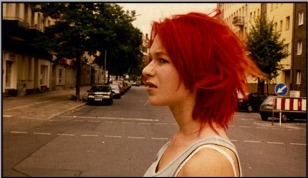
Toward a Theory of Agentic Orientation
From the first shot of Run Lola Run, the viewer is immediately pulled into a reality existing within a twenty minute time frame. Lola, a part-time thief is faced with the challenge of acquiring one hundred thousand dollars in twenty minutes, or else she and her boyfriend, Manni face possible death. Tom Tykwer weaves animation between scene transitions in the colorful story of Run Lola Run. He sets a heavy, suspenseful, and intense pace with quick beat music and constant jump cuts. Tykwer heightens the viewer's anticipation with repetition and a literally "glass shattering" scream Lola emits at the height of tension in the film.
Tykwer explores three individual scenarios in which Lola finds one hundred thousand dollars. He manipulates time with each repetition of her story. In the first, Lola is late. In the second, Lola is on time. In the third, Lola is early. Communication Theory journal explores the role of "victim, supplicant, and agent" and how an event occurs in one article, "Toward a Theory of Agentic Orientation: Rhetoric and Agency in Run Lola Run." After studying the film, they felt the "film has something to say about agency—in particular about the nature and function of agentic orientation." The viewer can apply this to one scene where Lola bumps into a woman and snapshots of the women's past are presented in ten seconds. At this moment the woman is the victim, Lola is the supplicant, and the agent is the two meeting at a blind corner, leading to the run in.
Run Lola Run challenges the viewer to find the real meaning behind chance, coincidence, and perception of time. It points to the question of control over one's destiny and the significance of human interaction. Tykwer also seeks to define define an objects potential through the many routes Lola takes to get what she wants.While this film could be analyzed as a simple action film confronting the constraints of time, Lola's contact with others in striking and powerful moments give the viewer insight into human nature and its role in relationships
From the first shot of Run Lola Run, the viewer is immediately pulled into a reality existing within a twenty minute time frame. Lola, a part-time thief is faced with the challenge of acquiring one hundred thousand dollars in twenty minutes, or else she and her boyfriend, Manni face possible death. Tom Tykwer weaves animation between scene transitions in the colorful story of Run Lola Run. He sets a heavy, suspenseful, and intense pace with quick beat music and constant jump cuts. Tykwer heightens the viewer's anticipation with repetition and a literally "glass shattering" scream Lola emits at the height of tension in the film.
Tykwer explores three individual scenarios in which Lola finds one hundred thousand dollars. He manipulates time with each repetition of her story. In the first, Lola is late. In the second, Lola is on time. In the third, Lola is early. Communication Theory journal explores the role of "victim, supplicant, and agent" and how an event occurs in one article, "Toward a Theory of Agentic Orientation: Rhetoric and Agency in Run Lola Run." After studying the film, they felt the "film has something to say about agency—in particular about the nature and function of agentic orientation." The viewer can apply this to one scene where Lola bumps into a woman and snapshots of the women's past are presented in ten seconds. At this moment the woman is the victim, Lola is the supplicant, and the agent is the two meeting at a blind corner, leading to the run in.
Run Lola Run challenges the viewer to find the real meaning behind chance, coincidence, and perception of time. It points to the question of control over one's destiny and the significance of human interaction. Tykwer also seeks to define define an objects potential through the many routes Lola takes to get what she wants.While this film could be analyzed as a simple action film confronting the constraints of time, Lola's contact with others in striking and powerful moments give the viewer insight into human nature and its role in relationships
Goodbye Lenin

Wolfgang Becker explores a happier side of life in the Eastern German block in his part historical, part fictional film, "Goodbye Lenin." The film is narrated by Alex, and is a mélange of live documentation from the fall of the Berlin Wall, and how this manifests and effects Alex's own narrative. Alex lives in two universes, one he fabricates to protect his mother and the other, a quickly "westernizing" Berlin. His desire to maintain this false reality advances the plot at a steady pace. Becker consistently fluctuates from past to present, inciting a sense of nostalgia for the old Berlin and a fear of change for the new country.
Becker's score for the film serves to intensify the somber mood with regard to Alex's dying mother. However, it is her belief in an ideal socialist state and the viewer's knowledge that the GDR no longer exists which augments the nostalgia. Becker limits his characters to small, defined spaces, for example the hospital and the home. The confinement to these spaces create suspense because the viewer anticipates the mother's discovery of united Germany.
Becker intends to show a lighter side of life in the Eastern block. He achieves this with the Mother, especially as her continuation of life as she knows it brings friends and neighbors to miss the "old days" as well. The viewer can validate Alex's actions in a scene where his mother reveals an unexpected truth about her past, one which she hid to protect her children. Here, Becker brings the characters together through their love for one another and their will to protect. Alex's desperate attempts to keep his mother unaware and alive bring the movie to a standstill. It is frustrating to see how Alex maintaining the past hurts his present life and his actions appear futile towards the end of the film. Ultimately it is the mother's death that allows Alex and the viewer to reconcile the past and present and accept a new united Germany.
Becker's score for the film serves to intensify the somber mood with regard to Alex's dying mother. However, it is her belief in an ideal socialist state and the viewer's knowledge that the GDR no longer exists which augments the nostalgia. Becker limits his characters to small, defined spaces, for example the hospital and the home. The confinement to these spaces create suspense because the viewer anticipates the mother's discovery of united Germany.
Becker intends to show a lighter side of life in the Eastern block. He achieves this with the Mother, especially as her continuation of life as she knows it brings friends and neighbors to miss the "old days" as well. The viewer can validate Alex's actions in a scene where his mother reveals an unexpected truth about her past, one which she hid to protect her children. Here, Becker brings the characters together through their love for one another and their will to protect. Alex's desperate attempts to keep his mother unaware and alive bring the movie to a standstill. It is frustrating to see how Alex maintaining the past hurts his present life and his actions appear futile towards the end of the film. Ultimately it is the mother's death that allows Alex and the viewer to reconcile the past and present and accept a new united Germany.
Vietnamese Identity

Anh Hung Tran explores the Vietnamese identity under French occupation during the 1950’s in “The Scent of The Green Papaya.” He focuses on the life of one girl, Mui, and her place in two different households. Hung Tran uses music to heighten the contrast between the two settings in which Mui lives.
He introduces Mui’s first home with traditional Vietnamese string music. The viewer can see many aspects of Vietnamese identity during the first fifteen years of Mui’s life. A hierarchy exists within this family, Mui learns how to cook native foods, the grandmother practices constant prayer, and the only music played is strictly oriental. When Mui moves in with the pianist, she discovers a presence of Western norms. Mui’s position as a servant remains static between the two families, but her environment drastically changes. In the new house, she hears classical music for the first time, tries on lipstick, and becomes fascinated with her appearance in the mirror.
The relationships Mui maintains with the members of the two families also shows cross culture variation. Mui suffers teasing and bullying from the boys of her first family. She never retaliates and always remains subservient, even to a boy younger than her. Hung Tran never shows Mui’s first mistress and husband interacting in a physical manner. However, Hung Tran portrays a much more physical relationship between the young pianist and his fiancée. He explicitly guides the viewer to believe they are sexually active before marriage. This portrayal of sex lends to French society. Ultimately, Mui represents the presence of Western norms in Vietnam when she becomes pregnant by the pianist. He teaches her how to read and write, a practice that women would not have learned in traditional Vietnamese society. Mui gains an unconventional type of independence, leading the viewer to question how the Vietnamese identity of women was changing.
Director Oliver Stone examines the Vietnamese identity through the eyes of Americans during the Vietnam War in “Born on the Fourth of July.” He follows the life of one marine, Ron Kovic, and how Ron’s views of the war change. Stone instills a strong sense of American patriotism and the will to win right from the beginning of his film. In the face of brutal warfare, Stone focuses on one voice of the American government: that the United States army is not at fault for crushing the Vietnamese people in order to root out communism.
Kovic believes in this ideal until he returns home to overwhelming voices of dissent and becomes conflicted about America’s real purpose in the war. Stone instills a sense of irony through the character development of Kovic as he begins to protest the war. The viewer does not anticipate Kovic's opposition to the war. The violence and dissent Kovic and his friends face during protests is the ultimate irony of the film. Kovic is called a traitor to America when he identifies with the Vietnamese as human beings.
While Stone never directly gives the Vietnamese a voice, Kovic comes to represent their identity. In one scene, Ron cries out in protest that the U.S. is “killing her brothers in Vietnam” and describes the Vietnamese as “pour peasant people who have been struggling for their own independence.” Ron’s plea for the U.S. to stop fighting for it’s own selfish rights ultimately brings to the foreground Vietnam’s struggle for an identity and an independence.
He introduces Mui’s first home with traditional Vietnamese string music. The viewer can see many aspects of Vietnamese identity during the first fifteen years of Mui’s life. A hierarchy exists within this family, Mui learns how to cook native foods, the grandmother practices constant prayer, and the only music played is strictly oriental. When Mui moves in with the pianist, she discovers a presence of Western norms. Mui’s position as a servant remains static between the two families, but her environment drastically changes. In the new house, she hears classical music for the first time, tries on lipstick, and becomes fascinated with her appearance in the mirror.
The relationships Mui maintains with the members of the two families also shows cross culture variation. Mui suffers teasing and bullying from the boys of her first family. She never retaliates and always remains subservient, even to a boy younger than her. Hung Tran never shows Mui’s first mistress and husband interacting in a physical manner. However, Hung Tran portrays a much more physical relationship between the young pianist and his fiancée. He explicitly guides the viewer to believe they are sexually active before marriage. This portrayal of sex lends to French society. Ultimately, Mui represents the presence of Western norms in Vietnam when she becomes pregnant by the pianist. He teaches her how to read and write, a practice that women would not have learned in traditional Vietnamese society. Mui gains an unconventional type of independence, leading the viewer to question how the Vietnamese identity of women was changing.
Director Oliver Stone examines the Vietnamese identity through the eyes of Americans during the Vietnam War in “Born on the Fourth of July.” He follows the life of one marine, Ron Kovic, and how Ron’s views of the war change. Stone instills a strong sense of American patriotism and the will to win right from the beginning of his film. In the face of brutal warfare, Stone focuses on one voice of the American government: that the United States army is not at fault for crushing the Vietnamese people in order to root out communism.
Kovic believes in this ideal until he returns home to overwhelming voices of dissent and becomes conflicted about America’s real purpose in the war. Stone instills a sense of irony through the character development of Kovic as he begins to protest the war. The viewer does not anticipate Kovic's opposition to the war. The violence and dissent Kovic and his friends face during protests is the ultimate irony of the film. Kovic is called a traitor to America when he identifies with the Vietnamese as human beings.
While Stone never directly gives the Vietnamese a voice, Kovic comes to represent their identity. In one scene, Ron cries out in protest that the U.S. is “killing her brothers in Vietnam” and describes the Vietnamese as “pour peasant people who have been struggling for their own independence.” Ron’s plea for the U.S. to stop fighting for it’s own selfish rights ultimately brings to the foreground Vietnam’s struggle for an identity and an independence.
Sound & Narrative in The Scent of Green Papaya
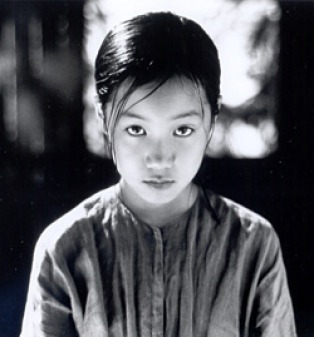
Das Leben der Anderen
Director Florian Henckel-Donnersmarck explores life in the GDR in the years leading up to the fall of the Berlin wall in 1989 through the lives of two men: Weisler, a Stasi officer, and Dreyman, a more liberal playwright. While the narrative is fictional, it is based on wide historical opinion and fact. The film parallels real time and builds the viewers suspense as the plot develops primarily through party officers desires for power. Florian follows Weisler's story, whose actions cause a large part of plot change. The film is restricted and it is not possible to understand why Weisler helps Dreyman. This unknown motivation creates a mysterious and suspensful mood. Florian intends to paint the Eastern block as oppressive, cruel, and powerful. He heightens the vicious nature of the government with Dreyman's struggle to write successful plays but remain in the good favor of the state party.
As the film unfolds, Florian employs music to heighten the mood. The film becomes more complex as Florian introduces a wider variety of instruments. During the set-up, a solo oboe is played, emphasizing the suspicious and curious mood which Weisler in turn acts out. For the remainder of the film, however, music comes to represent revolution and protestation. Styles of Jazz, rock, and folk are played to signify an escape or stand against party politics. In one scene, Dreyman and his directer, play music loudly to mask a discussion about an anti-party play.
Florian successfully paints a corrupt and terrifying government through the link he ties between Weisler and Dreyman as they both witness the "death of hope" under the GDR. He constructs the plot in a slow and intricate manner, allowing the viewer to notice every detail. Weisler comes to represent the emotional side of human kind, in the end being named "the good man." This film is a representation of natural human instinct, the kind and the malicious. It gives voices to the oppressed and powerful living East of the Berlin wall and compels viewers to examine this time in history with a greater understanding of man's nature.
As the film unfolds, Florian employs music to heighten the mood. The film becomes more complex as Florian introduces a wider variety of instruments. During the set-up, a solo oboe is played, emphasizing the suspicious and curious mood which Weisler in turn acts out. For the remainder of the film, however, music comes to represent revolution and protestation. Styles of Jazz, rock, and folk are played to signify an escape or stand against party politics. In one scene, Dreyman and his directer, play music loudly to mask a discussion about an anti-party play.
Florian successfully paints a corrupt and terrifying government through the link he ties between Weisler and Dreyman as they both witness the "death of hope" under the GDR. He constructs the plot in a slow and intricate manner, allowing the viewer to notice every detail. Weisler comes to represent the emotional side of human kind, in the end being named "the good man." This film is a representation of natural human instinct, the kind and the malicious. It gives voices to the oppressed and powerful living East of the Berlin wall and compels viewers to examine this time in history with a greater understanding of man's nature.
Les glaneurs et la glaneuse

The Gleaners and I is a compilation documentary that examines the evolution of "Gleaning" as a tradition in France. Director and camerawoman, Agnès Varda unconvers a bizarre link between present day gleaning in the countryside and scavanging by the predominantely homeless in cities. I am surprised by the connection Varda develops between this tradition and picking food out of trashcans. The mood becomes warm and personal as Varda interviews countryfolk, teenagers, artists, and working class people. She frankly asks them why they glean to bring a greater understanding to the viewer about the modernization of this practice. I see a categorization of gleaning through all the voices Varda highlights. There is an offbeat, whimsical tone throughout her entire story and the pace consistently shifts as Varda travels from town to town. The film is a series of live interviews and footage. The documentary is a form of "cinéma direct" where it takes place in real time. Varda juxtoposes her dialogues with all types of gleaners and achieves her aim of questioning man's wastefull nature. I feel compelled to question how wasteful my nature is. French society as well as American society disaproves of scavenging and using second hand items. Varda successfully challenges this notion. She realizes the potential of an individual object through conversations with wealthy artists who have used"junk" to create "masterpieces," and have profited in doing so. This, in turn, leads me to examine how I use my possessions and how I reuse them or if I discard them.
The Brother's Lumiere
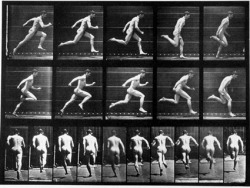
The Brothers Lumière is a very intriguing look into the earliest form of cinema in France. The idea held today that a film is a series of pictures fit together to make one continuous scene is completely lost by modern standard. This movie certainly makes me appreciate the work that must go into every clip (shots, lighting, angles)! The Brothers Lumière shows a significant focus on detail. Each clip had a story--rather a history or setting--but I find myself paying attention to the paths of individual characters. This film exemplifies the difficulty in capturing movement. Piano music emphasized the intended mood of the clips, at times mounting the humor, and other times creating a sense of foreign nature like in Egypte: panorama des rives du Nil. Overall the film was tedious but remarkable to watch and key to understanding the origins of French cinema.
Afrique, je te plumerai

Africa, I will fleece you
Jean Marie Teno réalise un documentaire sur l'histoire du colonialisme et la vie des politiques depuis l'indépendance du Cameroun. Il base son thème le plus fort sur la chanson des enfants aloutte. Il veut dire que les Camerounais sont les alouettes qui sont plumées par les Français qui colonisent le Cameroun. Teno augmente son thème d'anticolonialisme lorsqu'il met en contrait les coups de la propagande contrôlé par les Français pendant la deuxième guerre mondiale et les coups des protestations et de la violence contre les Français. J'avais de la difficulté à suivre le film parce qu'il y avait plein de coups qui venaient du colonialisme, de la révolution, puis des années plus récentes. Ils étaient tous mélangé avec la musique traditionelle et récente. Je crois que Teno a réussi avec son but d'anticolonialisme. Je pense qu'il avait assez de bonnes idées, pourtant le film enentière était trop d'information. De plus, le ton était si fort et lourd pendant tout le documentaire. Je crois que Teno a essayé d'enseigner trop des idées sur l'effet du colonialisme sur le Cameroun dans ce documentaire.
Jean Marie Teno réalise un documentaire sur l'histoire du colonialisme et la vie des politiques depuis l'indépendance du Cameroun. Il base son thème le plus fort sur la chanson des enfants aloutte. Il veut dire que les Camerounais sont les alouettes qui sont plumées par les Français qui colonisent le Cameroun. Teno augmente son thème d'anticolonialisme lorsqu'il met en contrait les coups de la propagande contrôlé par les Français pendant la deuxième guerre mondiale et les coups des protestations et de la violence contre les Français. J'avais de la difficulté à suivre le film parce qu'il y avait plein de coups qui venaient du colonialisme, de la révolution, puis des années plus récentes. Ils étaient tous mélangé avec la musique traditionelle et récente. Je crois que Teno a réussi avec son but d'anticolonialisme. Je pense qu'il avait assez de bonnes idées, pourtant le film en
Born in the Brothels
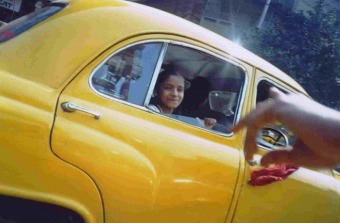
A documentary directed by Zana Briski and Ross Kauffman, Born in the Brothels is a powerful story of children living in the Red Light district of Mumbai who struggle with the poverty and degradation of prostitution. The film follows 8 children as they are taught to take basic photographs by Briski. A strong sense of hope comes through the unaffected, joyful nature of each child. Briski creates an intense constrast between the raw happiness of the students and their desperate existance in the brothels. The young boys and girls are more than just insightful and perceptive. Their interviews show a striking understanding of their dismal reality. Briski emphasizes the social constraints that hold the children back from escaping poverty. The personal interviews, juxtoposed with live footage of the children’s photo taking adventures achieves Briski's goal of bringing attention to the Western world of those « born in the brothels. » I found the movie disturbing and sadly compelling. I felt the frustration and drive behind Briski and her will to give these children an opportunity for education and a life outside of poverty. When describing one photo, Anjivit says « its is filled with sadness but I must look at it, because it is the truth. » I believe this statement encompasses the entire meaning of the film. I find this movie hard to watch. That does not mean, however, that we can overlook the harsh reality. Life is not a Hollywood fairy tale.


